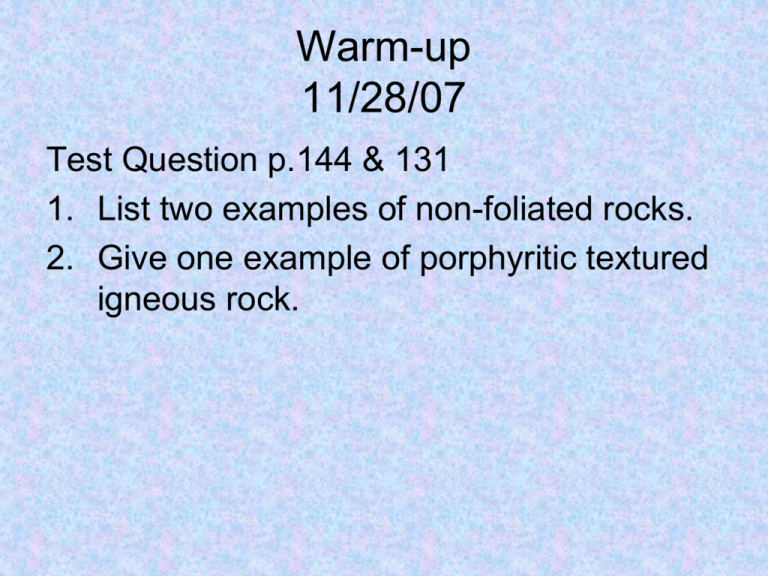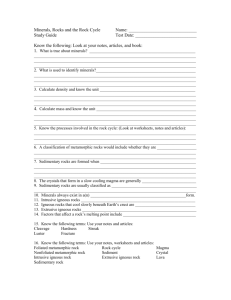Rock Cycle
advertisement

Warm-up 11/28/07 Test Question p.144 & 131 1. List two examples of non-foliated rocks. 2. Give one example of porphyritic textured igneous rock. Warm-up 11/14/07 1. How many minerals have scientists identified? 2. What is the most common silicate mineral? ROCKS Chapter 6 Starter 11/09/07 List the names of five rocks that you are familiar with. Describe the characteristics of the rock and identify how each type is used. Objectives Identify the three major types of rock, and explain how each type forms. Summarize the steps in the rock cycle. Explain Bowen’s Reaction series. Major Types of Rock Igneous Rock Latin for “ from fire” Form when magma cools and hardens Sedimentary Rock Fragments of rocks, Minerals, crystals and organic matter Sediment carried by weather Major Rock Types Metamorphic (changed) Rock Forms when existing rock is altered Pressure, extreme heat, chemical forces Rock Cycle Types of Rocks and How they are Formed R O C K C Y C L E N.L. Bowen Canadian Geologist 1900s Different minerals form at different times Bowens Reaction Series Bowen’s Reaction Series Explains the order in which minerals form as magma solid. Objective Summarize the factors that affect the stability of rocks. Sec 2 Objectives Summarize three factors that affect whether rocks melt. Describe how the cooling rate of magma and lava affect the texture of igneous rocks. Classify igneous rocks according to their composition and texture Describe intrusive and extrusive igneous rock structures Igneous Rocks Magma cools and hardens Identified as crystalline Identity = Chemical composition and texture Formation of Magma Three factors that affect rock melt 1. Temperature 2. Pressure 3. Presence of fluids Partial Melting Different minerals in rock melt at different temperatures Fractional Crystallization Crystallization and removal of different minerals from the cooling magma Igneous (Magma) Rocks Volcanic (extrusive) formed at earth’s surface Igneous (Magma) Rocks Dike Plutonic (intrusive) formed below earth’s surface Texture Coarse-Grained= large mineral grains Ex. Granite Fine-Grained= composed of small crystals Ex. Rhyolite Porphyritic= large and small Ex. Granite Glassy= cools quickly, small % of crystals Ex. Obsidian Vesicular= rapid cooling, vesicles Ex. Pumice Composition Felsic- rich in feldspars & silica, light color Mafic- rich in Mg & Fe, dark color Intermediate- low portion of silica What is the difference between stocks and batholiths? Intrusive Igneous Rock Structures Batholiths Deep rock, cover 100 km² Stocks Cover less 100 km² Laccoliths Laccoliths “lake of rock” Occur in groups, dome-shaped mountains What is the difference between a dike and a sill? Extrusive Igneous Rock Structures Igneous rock masses that form on Earth’s Surface. Warm-up 11/16/07 True or False 1. Fine-grained igneous rock result from rapid cooling. 2. Mafic magmas generally produce lightcolored rocks. 3. During partial melting, minerals that have lower melting points melt first. Igneous Characteristic Chart CoarseGrained Mafic Felsic Intrusive Extrusive Fine-Grained Sedimentary Rock Fragments of rock, minerals, organic material Characteristics determined- source, travel/move, and deposited Sedimentary Rocks Sandstone Conglomerate Limestone Shale • Eroded rock pieces carried by water, deposited in layers, pressed down by other layers until they form rock CH 6 Sec 3 Objective 1 Explain the process of compaction and cementation. Two main processes that convert sediment to sedimentary rock- compaction and cementation. Compaction Sediment is squeezed, pore space reduced from pressure of layers Cementation Sediment are glued together by minerals that are deposited by water. Objective 2 Describe how chemical and organic sedimentary rocks form. There are three main classes of sedimentary rocksChemical, Organic, and Clastic Chemical Sedimentary Rock Forms from minerals that were once dissolved in water Some form when dissolved minerals precipitate out of water because of changing concentrations Organic Sedimentary Rock Forms from remains of living things Objective 3 Describe how clastic sedimentary rock forms. Over time, individual fragments may be compacted and cemented in solid rock. The rock formed from these deposits is Clastic Sedimentary Rock Clastic Sedimentary Rock Classified by size of sediment 1. Large fragments- conglomerate, breccia 2. Sand-sized grains- sandstone 3. Clay-sized particles- shale Characteristics Sorting Currents of air or water separate sediment according to size Angularity Particles break from source rock, tend to angular and uneven Objective 4 Identify seven sedimentary rock features. Stratification, Cross-Beds, Graded Bedding, Ripple Marks, Mud Cracks, Fossils, Concretions Read p. 138-140- two bullets per feature Warm-up 11/20/07 1. Describe how clastic sedimentary rock differs from chemical and organic sedimentary rock. P.136 Clastic rock forms from rock fragments that were transported away from their source by weather, rather than chemical processes. Chemical Limestone Sandstone Breccia Evaporites Shale Clastic Organic Metamorphism Heat, pressure, or chemical Rock changes from one type into another Forms from igneous, sedimentary, or metamorphic Formation of Metamorphic Rocks Heat, pressure, and hot fluids = minerals change to other minerals Type of rock indicates conditions from original rock Two Types Contact with magma Plate tectonics Contact Metamorphism Magma comes in contact with existing rock Only small area of rock that surrounds the magma is changed Chemical fluids through fractures Regional Metamorphism Occurs over a large area Movement of tectonic plate cause heat and pressure against another Chemical change in minerals Volcanism Both contact/regional Classification of Metamorphic Rocks Chemical composition/texture Minerals from original rock help determine type Either foliated or nonfoliated Foliated Rocks Minerals are arranged in planes or bands Ex. Slate, Schist, Gneiss Nonfoliated Rocks Do not have bands or aligned minerals Share 1 or 2 main characteristics Ex. Quartzite, Marble Metamorphic Rocks Schist From Basalt, Shale or Slate From Limestone or Dolomite Gneiss From Granite • Pressure and Heat morphs igneous or sedimentary rocks into metamorphic rocks






